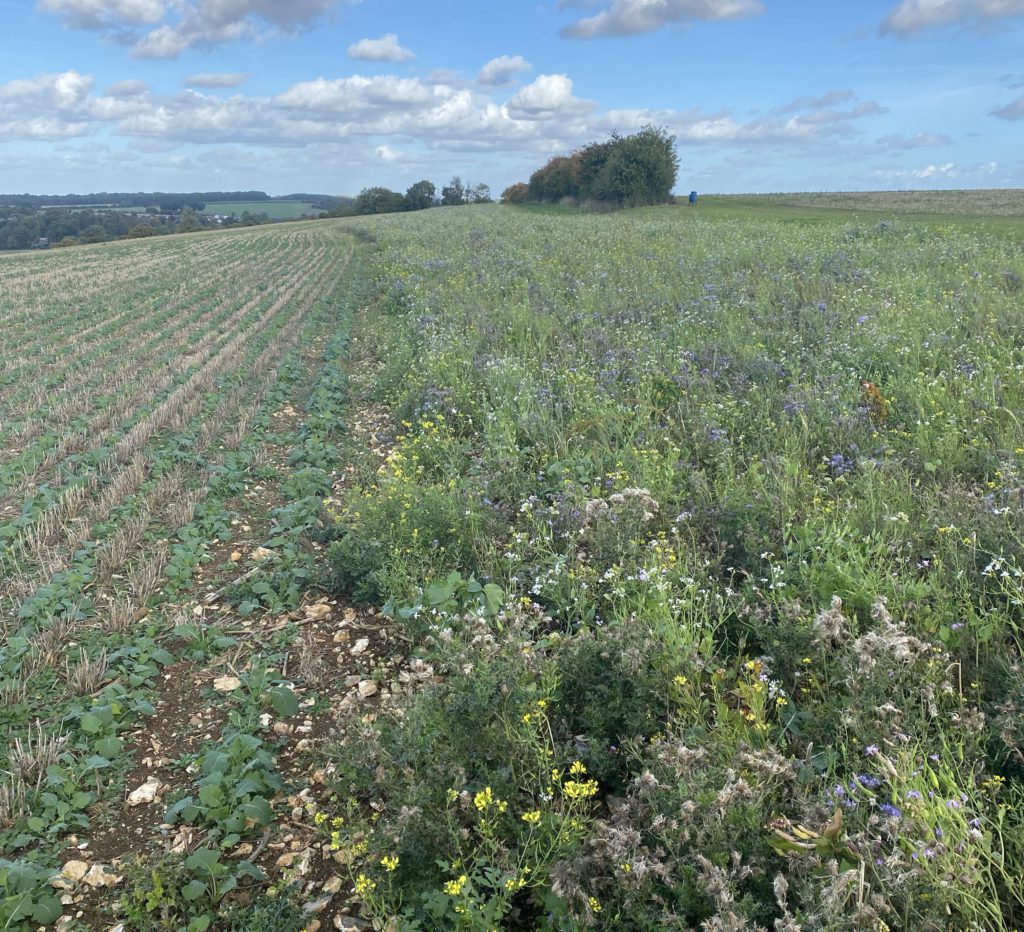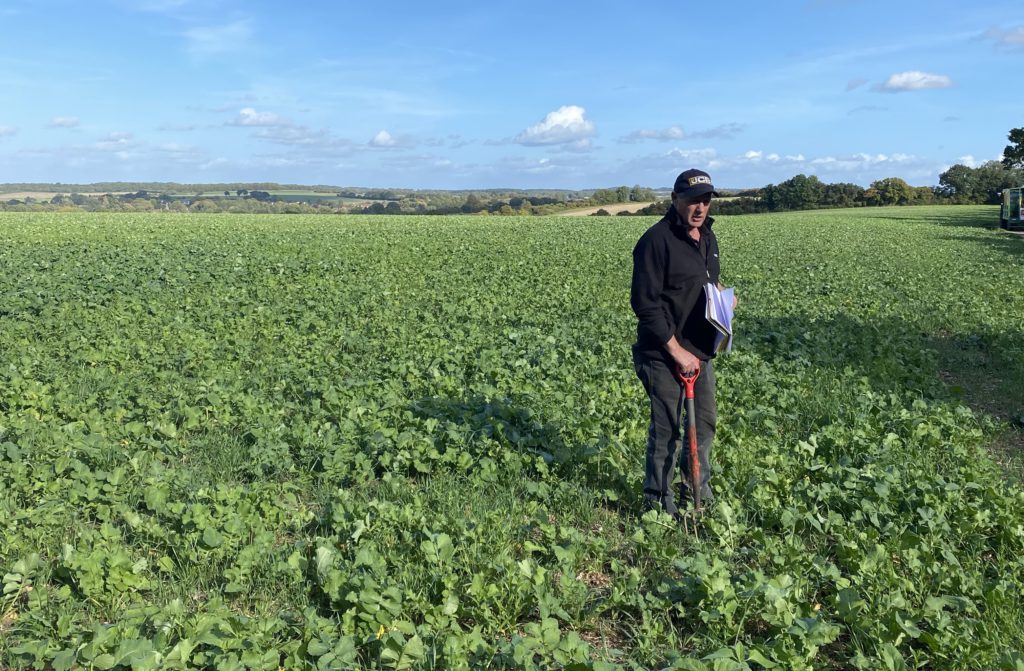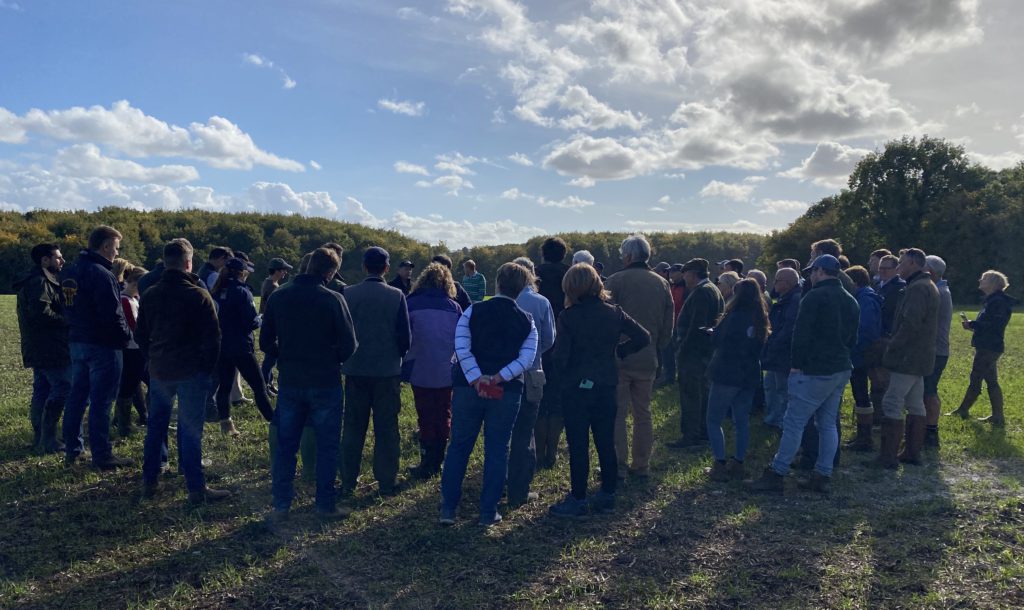
The second in our series of farm walks was with David Miller in Hampshire. This year’s Arable Soil Farmer of the Year, David is keen to demonstrate how a regenerative system can be both simple and profitable even on challenging soils. Managing 700ha of majority Grade 3 land in a purely arable rotation, David focuses on four of the main pillars of regenerative farming – keeping the soil covered, diversifying the rotation, maintaining a living root and minimising soil movement – proving a regenerative system without livestock.

The 700ha farm has been managed under a regenerative system for the previous 7 years, focusing on minimising tillage and incorporating diverse cover crops into the rotation. The move was triggered by rising input costs without the reciprocal rise in expected yield – a change of system was needed to improve profitability and farm resilience. David explains,
“The overriding ambition is for our soils to be much more biologically active and more resilient. Resilience can be defined as, being able to function and produce a healthy crop with minimal interference, either mechanical or chemical and to continue to do this year after year”.
Initially cautious to make the transition, due to the perceived cost of a system focusing on the soil, David conducted a series of trials over a 5 year period; following this the investment was made for a no-till drill to maximise the benefits of the cover crops within the rotation.
With the farm located around 600 ft above sea level and containing large quantities of flint, the soil David manages is challenging from many perspectives. Moving to the no-till system has seen vast improvements to the fixed costs of the farm,
“We have much less depreciation on machinery and save a lot of diesel compared to our previous practices.”
David reveals that prior to their transition when conventionally farming they averaged 85 litres/ha of diesel for the whole year compared to only 50 litres/ha now. The current system also means there is a lower staffing requirement, with the 700ha farm only having one full time member of staff supported by two part-time workers to assist with spraying and harvesting.
Reducing inputs has been a key focus of David’s throughout the journey so far. Historically DAP (diammonium phosphate) has been used to establish crops alongside applications of potassium however now with the cover crop system in place this is deemed no longer necessary.
“The harder you push a farm conventionally with high inputs the harder it is to come back”
– David suggests.
Inputs were steadily reduced over time as the system came into balance, he explains
“The cycling phosphate and potassium was actually at a deficit for a few years as it was tied up in our cover crops. Over time this system has equalised and now we are self-sufficient, cover crops mine the nutrients that were once unavailable within soil that we need for the arable system”.
The farm has had no phosphate or potassium fertiliser for 7 years and has reduced nitrogen fertiliser by 25%, when explaining how he has achieved this he states,
“We have adopted a nitrogen dose reduction strategy alongside making cropping changes (spelt wheat or spring milling wheat rather than winter wheat) whilst lowering chemical costs through a more targeted approach combined with a more flexible risk strategy – we put less money at risk in each crop and therefore we are able to budget for lower yields and margin is our driver.”
David is a believer of testing theories and trialling ideas on the farm, a fertiliser rate trial demonstrated that up to half of the total nitrogen applied was used to produce the last tonne of yield (9 tonnes to 10 tonnes/ha) –
“We are trying to get a consistent yield from a consistent application of fertiliser, if we can understand what’s going on in the soil a little bit more we are likely to be able to reduce our synthetic fertiliser even more”.
Reducing the spray program has also made great savings from both an input and fuel perspective. Insecticides are rarely used on the farm despite the large OSR acreage, instead relying on providing habitats for invertebrate species and beneficial predators to deliver pest control. This has been encouraged by establishing 4 metre margins around all the fields with indigenous species such as mayweed, speedwell and wild carrot which historically would have been considered arable weeds, but provide the habitat to encourage the species within their own local ecosystem. David describes this thinking,
“A healthy, active soil is just one component of a healthy, active environment – getting the biological balance in the soil requires, or results in, getting a balance of invertebrates, predators, beneficials and pests”.
An example of this promotion of beneficials and biological influence on the cropping system is the companion crops used during establishment of the oilseed rape, David explains,
“We try and keep the companions in for as long as we can to help with the mycorrhizal fungi but we avoid having them in the crop at harvest as it can make combining tricky – the species we choose are either not tolerant to the frost or can usually be taken out with the normal herbicide program.”
Establishing the crop using this system has meant no insecticide has been used in 4 years, with no requirement for starter fertiliser, “The seed and companion crop are about £30 per hectare, so if we loose a little bit it is not the end of the world – we’ve given up trying to keep a bad crop of rape”.

Having moved away into a no-till drilling system has itself presented new challenges with crop establishment as David tells the group
“As we no longer apply fertiliser at drilling and have very little mineralisation of nitrogen through cultivation establishment can be much slower. However, once crops are established they seem far more resilient and having had a dig they have a far more developed root architecture than in our previous system.”
The rooting patterns now achieved on the farm also provide the crops with a better foundation during tricky weather, with David observing that in particular the wheat can now stand longer periods of drought. Growing crops such as the spelt can leave a lot of straw residue behind after harvest, David explains that a proportion of the straw will be baled but the majority is chopped and left to biology to disperse,
“If we are confident that we have a good worm population that helps with the straw management following harvest as they take it down into the soil and decompose it.”
When discussing cover crop choice and management David has a key strategy,
“The cover crops which are deemed to be the ‘best’ are those with big top growth and leafy canopies. I however am interested in what’s going on below ground – big cover crops with a lot of above ground biomass use a lot of the available nitrogen in the soil and we don’t tend to see the same benefit to the following crops”.
David blends his own cover crop mixtures from straights, aiming to spend approximately £30/ha on the seed.

David discusses his thinking in choosing cover crop combinations,
“We used to have a lot of radish in the covers in the early days, we found this led to finding a massive amount of slugs. So we therefore decided to remove brassicas from the mixes for a few years, we are now just starting to put a couple back into the mix as they seem to dominate very quickly.”
Crops are established either using a Horizon DSX drill or on occasion a Horsch C04 if there is a large quantity of straw when drilling cover crops. In regards to establishing the following crop after the cover David describes his approach,
“If we get a chance in the winter with a hard enough frost we will come out with a set of cambridge rolls to start to terminate some of the leafier covers, but eventually we will use a low rate of glyphosate (2-3 litres of 360g) before we drill in the spring”.


David maintains flexibility within the system by not having a set rotation and also using environmental stewardship options to aid trickier areas of ground, he explains
“I would say that our soil structure is improving across most of the farm – some heavier fields which have been more reluctant to accept no-till have been included in our stewardship scheme and planted with AB15 or a 2-year legume mix. Also, active clovers in place for 2 years have formed very strong tap roots and improved the soil structure a lot.”
Since converting from a high-input, conventional system there has been many notable changes in the quality and condition of the soil, David explains
“It has probably taken 4 or 5 years, but the soils are now visibly more friable and better structured – this is underpinned by the old and living roots as well as the many worm channels. Observational changes can happen in the first couple of years but the quantifiable changes become far more apparent after around 5.”
David is keen on assessing the land through many different approaches to measure the resilience and functionality of the soil, he says
“Slake tests are showing soils are less fragile and hold together better when we get heavy rain, this is seen in the fields as our infiltration rates have definitely increased and the fields are much cleaner following downpours.”
David is also a strategic farm for the AHDB where he looks to be able to quantify some of the anecdotal theories in partnership with NIAB, increasing the confidence in the practices for other farmers considering converting,
“The regenerative system is such a long-term journey it is sometimes difficult to know what to try and measure, let alone how”.
In particular being able to understand the best approach to lessening the usage of fungicides and nitrogen alongside the impact healthy soils has upon the nutritional density of the food produced.
The 2023 Soil Farmer of the Year competition launches on the 5th of December 2022. Established in 2015, the competition is run by the Farm Carbon Toolkit and helps find, promote and champion UK farmers who are passionate about their soils. With awards presented annually at Groundswell Agricultural Show, the competition is widely recognised within the industry and beyond as a fantastic platform for farmers to share their knowledge and experience. If you are interested in entering the competition or would like to read further articles about previous winners please visit the Farm Carbon Toolkit Soil Farmer of the Year website here.


Recent Comments